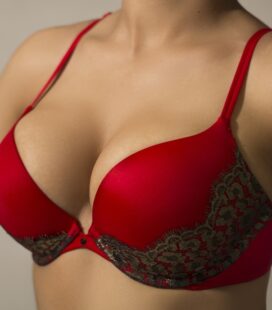For most, the primary goal of breast augmentation is to make the breasts more attractive. So it’s understandable that many prospective patients are concerned about scarring. Why improve the size and shape of the breasts if it’s simply going to add a visible scar? The good news is that breast augmentation here in my Toronto clinic isn’t known for leaving behind significant scars. That’s because I use surgical techniques that further minimize visible scarring after breast augmentation, ensuring results that look remarkably natural.
Incision Location
In any surgery, the incision is where the scar will eventually develop. And in aesthetic procedures, it’s vital to be mindful of scar development when planning and executing incisions. Any breast augmentation procedure will use 1 of the following incision types:
- Inframammary incision: This is the most common incision used in breast augmentation. The inframammary incision is carefully made along the breast crease, where the lower breast meets the chest. This incision provides me with a large area of control during surgery and still heals to a discreet scar that is well hidden beneath the breast.
- Periareolar incision: This incision traces around the lower portion of the areola, which is the area of coloured skin around the nipple. The resulting scar usually blends in quite smoothly with the natural colour border here.
- Transaxillary: Here an incision is made in the armpit. Although many patients consider this a desirable location for the incision, it’s the least common option because it’s only appropriate in particular circumstances.
As I mentioned in a previous blog post, however, I tend to avoid the latter 2 incision sites because they typically harbor the most bacteria. Fortunately, our clinic offers yet more options for reduced scarring.
A “No-Touch” Technique
In my practice, I am pleased to use a device called the Keller Funnel® to assist me when placing implants. The device looks a bit like a pastry bag. The implant is carefully poured in the wide end and I use the narrow end to deliver and propel the implant to the breast pocket. This reduces to zero the amount of contact I have with the implant and therefore reduces the risk of contamination and infection. More importantly, it reduces to zero the contact between the implant and the patient’s skin, including her areola (again, bacterial issue). It also enables me to use a smaller incision, since the narrow “delivery” end of the funnel is quite small.
Saline Implants
Finally, for patients significantly concerned about scars, saline implants may be better choices than silicone ones. Unlike silicone implants, which are completely intact when placed in the breast pocket, saline implants are placed when empty. Once they are in place within the body, I add their sterile saline fillings. By placing only the shells first, I can use extremely small incisions.
Post-op Scar management
We offer a variety of post-operative scar treatments at the office to facilitate the healing and the final scar appearance. Those include but are not limited to: IPL/BBL light treatment, HALO and profractional erbium laser treatment, Scar Recovery Gel, a variety of Biologique Recherche’s Repair Creams and Serums and several lightening creams for the skins predisposed to hyperpigmented healing.
Of course, the best way to deepen your understanding of the types of scars left behind by breast augmentation is by seeing them for yourself. Please view my gallery of before-and-after photos to see how my previous patients’ incisions have healed, and learn about what you can expect for yourself. Or why not contact us to schedule a visit to get your questions answered? I look forward to speaking with you.


















